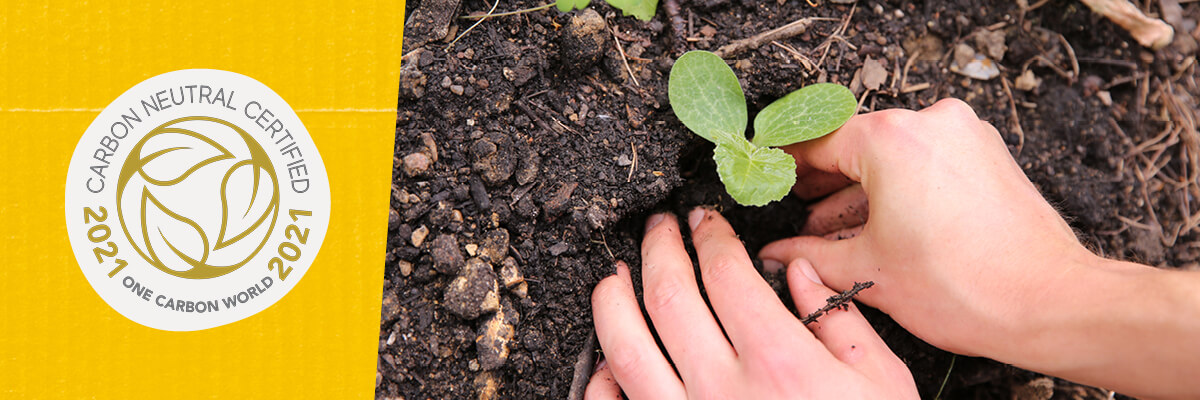We're Carbon Neutral!

May 2021: We're incredibly proud to be the first organic food delivery company in the world to achieve both the Carbon Neutral International Standard and to join the United Nations' Climate Neutral Now Initiative. Keep reading to find out more about what carbon neutral means, how we've been measuring our carbon emissions, and our plans for the rest of 2021.
Being certified carbon neutral means that we've calculated how much carbon we emit as a business (our 'carbon footprint'), and have reduced this to zero through a combination of reducing our emissions internally and supporting external carbon 'balancing' projects.
We've been certified as carbon neutral by One Carbon World, a global resource partner of the Climate Neutral Now Initiative, which was launched by United Nations Climate Change (UNFCCC).
HOW HAVE WE BEEN MEASURING OUR CARBON EMISSIONS?
When it comes to carbon, we're committed to meaningful change. As our Communications & Sustainability Officer, Ed, explains: "We want to go beyond simply offsetting, or carbon 'balancing', to actively measure and reduce our emissions. So we've been working with Environmental Management Consultancy, Green Element, to measure our Scope 1, 2 and 3 emissions."
Scope 1 emissions are direct emissions from any owned or controlled sources – an example would be the fuel that our vans use. Scope 2 emissions are indirect emissions that come from the generation of purchased electricity. And Scope 3 emissions are all indirect emissions that occur in the value chain – this includes things like our waste, water usage and the production of uniforms.
To achieve the most accurate figure for our reporting and make the most meaningful change, we needed to work with the last full year’s worth of data, which at the time of certification was 2020. It’s important to remember that even though we’re growing, we’re still committed to measuring and reducing our carbon footprint every single year.
Our research has given us a clear understanding of where our carbon 'hot spots' are, and we'll be working to reduce all three of our Scope emissions.
"In the past, many businesses worked on becoming 'net zero' just in terms of their Scope 1 and 2 emissions, as they're seen to be outputs that you have direct control over. But in reality, these only make up around 20% of a business' total emissions. We don't believe that Scope 3 emissions are solely someone else's responsibility. The key is that we all work collaboratively together to reduce our carbon emissions," says Ed.

HOW WILL WE CUT BACK ON OUR CARBON EMISSIONS?
We're putting together a roadmap to reduce our carbon emissions even further. For us, it's important that we look at both what we can do in the short-term, through carbon 'balancing' and reduction measures, like ensuring we have renewable energy sources at all of our sites, and that we also have a comprehensive, long-term reduction strategy in place.
To create this strategy, we'll be aligning with the Science Based Targets initiative (or the SBTi), set up by the UN Global Compact, World Resources Institute, CDP and the World Wildlife Fund. This means that we'll be working towards the target set out in the Paris Agreement, which is not exceeding global warming by more than 1.5°C, compared to pre-industrial temperatures.
"Our work with the SBTi will make sure that we're pushing ourselves to achieve ambitious carbon reduction targets. To do so, we will publicly pledge our targets to the SBTi, who have strict standards for businesses to meet to be a part of the initiative," explains Stef, our Head of Sustainability.
"For this, we'll be developing an even lower-emission fleet. We're really proud of our sustainable delivery model, which is already designed to be carbon-efficient, but there's always room for improvement. We're also hoping to start 'insetting' from 2022 - this means balancing carbon emissions within our own supply chain. It's something that we've already begun work on through our Responsible Supplier Programme, where we measure our suppliers' environmental impact, and then work together to improve on this."

SO, WHAT'S NEXT?
"We're on track to have our carbon emission reduction targets finalised and be signed up with the SBTi by the end of 2021. From there, we'll have a really clear roadmap as to what we want to achieve, and by when," says Stef.
HOW CAN YOU HELP MAKE A DIFFERENCE?
We want to provide easy ways for you to help the planet. So now, you can support sustainable carbon reduction practices while you shop, through donations to the La Pitanga afforestation project in Uruguay.
The main objective of the project is to restore land and sequester carbon through sustainable afforestation, using practices which are compatible with the FSC standard for sustainable forest emissions.
We're also working with La Pitanga to carbon 'balance' our emissions, which is one of the short-term solutions in our carbon reduction strategy. Any donations that you make will be completely separate and incremental to our own.
To help support La Pitanga's vital work, simply choose a donation amount and add it to your next sustainable shop, here.

Published July 2021


